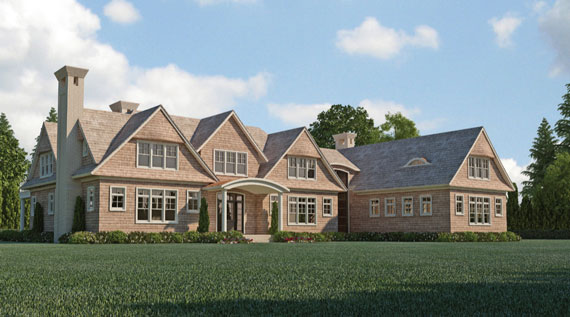Joe Farrell is back — back, that is, to building the super-sized, deluxe Hamptons spec homes that were his trademark before the crash.
Recently, in addition to the 4,000-square-foot homes costing $3 to 5 million he largely built for a few years after the financial meltdown, Farrell’s prices and square footage have crept up.
Now, two of his properties on the market are selling in the $15 million and $20 million range, including an 8,600-square-foot manse on two acres in Bridgehampton across from a golf course. About 16 of his homes are priced in the $5 million to $15 million range.
“We go where the buyers are,” said Farrell, president of the Bridgehampton-based Farrell Building Company.
It’s no surprise that buyers are willing to spend again. Overall, average luxury residential prices for the Hamptons reached $7.67 million in 2014, up from $6.22 million in 2010, according to the Corcoran Group.
But scarcity of land has led Farrell to satisfy demand for his enormous, newly-constructed dwellings by building north of Route 27.
“Very wealthy people who could live anywhere are moving north,” he said. “They want a big piece of land and that doesn’t exist south of the highway.”
Even with the larger, pricier homes, Farrell has kept the vast scale of his operation the same, churning out large numbers of houses at a rapid pace. He has 32 spec homes in various stages of the sales process with about 25 in contract, all of them turned out by an in-house staff of 50 architects, contractors and other employees. He also owns an excavator, a masonry and a carpentry company. He produces a newly minted mansion in six months to a year, many of which are sold before they’re finished. Last year, Farrell sold 39 houses for close to $200 million, making him the biggest residential developer on the East End.
Since leaving his job on Wall Street as a commodities trader and setting up shop in 1996, Farrell’s company has built more than 400 homes worth over $1 billion.
“He works on a big scale. He has his own team. And he really has changed the way things are done in the Hamptons,” said Gary DePersia, a broker with The Corcoran Group in East Hampton.
Not everyone likes the change. His ubiquitous cookie-cutter design, with cedar shakes and gambrel roofs, among other features, has led detractors to dub Farrell the builder of Hamptons-style McMansions.
“I wish there was more differentiation between the houses he builds,” said a Hamptons broker who didn’t want to be named. “It’s why people talk about the Farrellization of the Hamptons,” the broker said.
For his part, Farrell dismisses such criticism as sour grapes. “When you’re on top, there are always people who are going to criticize you,” he said. “But the true test is what customers say.”

Joe Farrell
In fact, according to Farrell, that sameness is an important part of his appeal. It’s especially important for selling homes on spec, often before construction has begun. “People know what to expect,” he said. “They know our brand.”
Even Farrell’s competitors admit the mega-builder has been a positive force in the industry.
“A lot of his houses look alike but that doesn’t make them bad,” said Michael Axelrod of M&M Custom Houses. “He does a very nice job building high-end homes.”
Uber-developer Michael Davis said Farrell has “undoubtedly filled a niche in the market.”
Bonny Aarons, a real estate agent with Douglas Elliman in East Hampton, said her clients ask for his houses. “He gives buyers a lot for their money,” Aarons said.
Those buyers include a roster of such celebrities as Madonna, Kelsey Grammer and Rudy Giuliani.
Farrell spent the years before the crash selling homes in the $7 million to $20 million range. But, according to Farrell, he saw the writing on the wall and, before the market imploded, he sold almost all his properties.
During the recession, he built a $43 million, 17,000-square-foot mansion in Bridgehampton, which he and his family moved to. He said he built it mostly to keep his staff occupied. Now he usually rents it for two weeks every summer. In 2012, his tenants were Beyoncé and Jay Z, who leased the house for $400,000 a month during their stay.
When he dove back into business in 2011, he decided to move to the lower end of the luxury market, churning out $3 million to $7 million homes and an occasional $10 million pad. It’s just in the last year or so that he decided the demand was there for bigger, much pricier mansions.
Many of those are being built north of the highway. Since it’s farther from the ocean, the area traditionally has been regarded as less desirable. But a number of builders have been turning northwards recently as land becomes increasingly difficult to find. About half of Farrell’s inventory is located in those areas — for example, several two to four-acre lots on a horse farm in Water Mill that is north of the highway are currently for sale. The 7,500- to 8,000-square-foot homes on them are selling for $8 million to $10 million.
That shortage of, and fierce competition for, land may be Farrell’s most intractable challenge for now. “I haven’t seen land this tight in my career,” he said. With opportunities to buy dwindling, Farrell is focusing on selling his inventory rather than buying more lots, at least until the fall.
Because of the scarcity of available land, Farrell’s focus also continues to be on Water Mill, Bridgehampton and Sagaponack. Last year, he made a big push in Amagansett, selling 15 houses in the $5 million to $9 million range. This year, however, he has only two homes in that area.
In the past few years, Farrell has started to face stepped-up competition from other spec builders, but he insists he’s not concerned.
“When the market is good, you’re doing a good job and giving people value, the other companies don’t affect us,” he said. The recent trend for Wall Streeters to stay in New York City and, rather than move to the suburbs, buy a house in the Hamptons also works in his favor, according to Farrell.
Still, Farrell’s love affair with the Hamptons may be waning. He is branching out into new markets and is about to break ground on an 800-unit storage facility in Port Jefferson, New York, and a 160-unit multi-family building in Newburgh, about an hour and a half from New York City. And he plans to construct more such buildings.
“You’ve got to keep moving,” he said.
